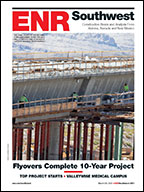Nevada recently approved using a public-private partnership for a massive, costly upgrade to a heavily traveled section of Interstate 15 in downtown Las Vegas. Called Project Neon, the plan is meant to improve a 3.7-mile stretch of I-15 between Sahara Avenue and the U.S. 95/I-15 "Spaghetti Bowl" interchange, which sees 250,000 cars daily. Traffic through the corridor is expected to double by 2030.
“We received an unsolicited bid a year and a half ago and vetted the proposal. We found it would be beneficial to enter into a public-private partnership. It would take us 20 years to do a pay-as-you-go approach,” says Rudy Malfabon, director of the Nevada Dept. of Transportation. “This approach minimizes public impact, allowing us to get in and out, while putting in place capacity and safety improvements that will last 20 years.”
The five-phase project will reduce traffic weaving, improve safety and cut congestion-related crashes. Improvements call for a one-mile-long high-occupancy vehicle (HOV) connector between U.S. 95 and I-15, plus direct HOV access ramps at Wall Street, reconstruction of the Charleston Boulevard interchange, a Martin Luther King Boulevard-Desert Lane connection and a Grand Central Parkway connector over Charleston Boulevard, among other fixes. The total price tag is $1.8 billion, with construction scheduled to take place from 2015 to 2018. Project Neon is expected to create 4,100 jobs. Right-of-way acquisition and preliminary demolition are already under way.
A consortium led by ACS Infrastructure Development Inc., a Coral Gables, Fla.-based unit of Actividades de Construcción y Servicios S.A., has proposed to design, build, finance, operate and maintain Project Neon for 35 years after completion. Four to five other unnamed teams are chasing the jobs, too. A contract is expected to be finalized in November 2014. CH2M-Hill, Englewood, Colo., is the owner’s program management consultant.
“We couldn't go to the bond market for the entire project because it would take away too many resources from the rest of the state,” says Nevada Transportation Board member Frank Martin. “This doesn't impact NDOT’s ability to maintain and build roads throughout the rest of the state.”
The Nevada Legislature has repeatedly rejected the use of toll roads, which means the developer will be paid by the state transportation department with fuel-tax revenue. Payments will be based on project milestones and facility performance standards. Although P3s are still new for Nevada, it could provide a template for future infrastructure funding. In the U.S., the use of P3s is gaining support among industry groups, such as the non-profit Association for the Improvement of American Infrastructure.
“Public-private partnerships give the state another tool to meet its infrastructure needs with little initial capital outlay,” says Sean Stewart, executive vice president of the Las Vegas chapter of the Associated General Contractors. “It allows a cash-strapped public agency to still serve a fast-growing community’s transportation needs by tapping private-sector resources. If structured correctly, P3s can create a win-win scenario for both parties.”
This story was corrected on July 23rd to reflect that ACS Infrastructure Development has only filed a proposal regarding the highway project.




Post a comment to this article
Report Abusive Comment